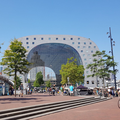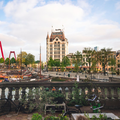
Central Station
Welcome to Rotterdam Central Station, the third central station the city ever had. Opened in 2014, this architecturally striking station is characterized by its angular, metal-clad design which points dynamically towards the city center. It replaced the previous central station in functionalist style that opened in 1957 which couldn’t accommodates over 110,000 passengers daily, integrating trains, trams, buses, and metro services under one roof. The station features a wide array of shops and dining options. A fun fact: the station's roof has solar panels that generate enough energy to support its internal operations. It was the largest solar roof in Europe when it opened in 2014.

City hall
Rotterdam's Stadhuis, built between 1914 and 1920, is a remarkable example of Dutch Classicism. This historic building, which miraculously survived the WWII bombings, serves as both a political and ceremonial center. The interior is richly decorated, featuring artworks, elaborate wood carvings, and stunning stained glass that depict scenes from Rotterdam’s history. The City Hall also houses the marriage chamber, popular for its lavish decorations. The building’s courtyard holds a special war memorial and is a beautiful location to visit. You can enter the courtyard for free from either side of the building, if the gates are open.

Markthal
The Markthal in Rotterdam is a remarkable feat of modern architecture and urban planning. Opened in 2014, this stunning building was conceived as part of the city's effort to revitalize the post-World War II downtown area and to offer residents a new kind of public space. The curved, horseshoe-shaped structure is not only an indoor market but also serves as a residential building, with apartments lining the arches above the market floor. This dual-purpose design embodies a novel approach in Dutch urban policy, integrating living, shopping, and leisure spaces into one cohesive unit.
The design of the Markthal is also a response to new Dutch laws requiring covered spaces for traditional open-air markets, providing a year-round shopping experience protected from the Netherlands' often inclement weather. The interior is famed for its vast mural, "Horn of Plenty," which spans the entire ceiling, depicting oversized fruits, vegetables, flowers, and insects in vivid colors.
Fun Fact: During the construction of the Markthal, archeologists discovered artifacts and remnants of a medieval village on the site, dating back to the 11th century. These findings, including ancient pottery and tools, were integrated into an exhibition beneath the building's glass floor, providing a literal window into Rotterdam's rich history.

Cube houses
Designed by architect Piet Blom and completed in 1984, Rotterdam's Cube Houses are a bold architectural experiment located near the bustling Blaak Station. These iconic structures represent an avant-garde approach to solving urban density challenges while creating functional living spaces. Blom designed each house as a tilted cube, perched on a hexagonal pylon, which creates the illusion of a forest of tree houses in an urban setting.
The architect envisioned these homes as an "urban forest," with each cube symbolizing a tree, collectively forming a woodland habitat.
The Cube Houses were conceived as part of Blom's broader vision to design a new residential area that was both visually appealing and highly functional within the constraints of a dense urban environment. The houses are tilted at a 45-degree angle to optimize the interior space and provide windows that offer expansive views of the sky, enhancing the sense of openness and connection with the environment.
Fun Fact: One of the cube houses has been transformed into a "show cube," which is open to the public. Visitors can explore the interior, which has been maintained to reflect the original design and functionality intended by Piet Blom. This provides a fascinating glimpse into living within a non-traditional, innovative architectural space.

Old harbour
The Old Harbour, known as Oude Haven in Dutch, is Rotterdam’s oldest port and a pivotal historical area that encapsulates the maritime spirit of the city. Established in the 14th century during a period of rapid urban expansion, the harbour served as the heartbeat of Rotterdam, facilitating trade and commerce that were instrumental in the city's development.
As Rotterdam grew into a major port city, the Old Harbour remained a central point, bustling with activity from ships and traders from around the world. The area is surrounded by historical buildings that survived the extensive bombings of World War II, including the White House (Witte Huis), which was Europe's first skyscraper built in 1898 in the Art Nouveau style. The survival of these structures provides a rare glimpse into the city’s pre-war architecture and urban fabric.
In the modern era, the Old Harbour has been rejuvenated, merging its rich historical legacy with contemporary urban life. The harbor is now lined with modern bars and restaurants, yet it still retains its historical charm with restored old ships moored in its waters, serving as floating museums that tell stories of the city’s maritime past.

Erasmus Bridge
The Erasmus Bridge, affectionately known as "The Swan" due to its graceful, asymmetrical cable-stayed design, is not just an essential transport link but also a stunning architectural landmark of Rotterdam. Completed in 1996 and designed by Ben van Berkel, this bridge spans the Maas River, connecting the north and south parts of the city, and has become an iconic symbol of Rotterdam's skyline.
The bridge's unique design features a single 139-meter high asymmetrical pylon, from which cables fan out to support the roadway, creating a visual effect that is both striking and elegant. The Erasmus Bridge is vital for daily traffic flow, accommodating cars, trams, pedestrians, and cyclists, and plays a critical role during many city events, such as the Rotterdam Marathon and the annual World Port Days festival.
The Erasmus Bridge is frequently studied and admired by architects and engineers globally for its distinctive aesthetic and the technical challenges it overcame during construction. The bridge exemplifies how functional infrastructure can also serve as a work of art, influencing bridge designs around the world and promoting Dutch engineering and architectural prowess on an international stage.

Maritime Museum
Located in the heart of Rotterdam, the Maritime Museum is a crucial institution that provides a comprehensive overview of the maritime world, highlighting why this sector is vital to understanding Rotterdam's identity and economic success. Founded in 1874, the museum stands near the bustling Leuvehaven, not just as a repository of maritime artifacts, but as a vibrant educational center that reflects the city's longstanding relationship with the sea.
Rotterdam's position as one of the world's leading ports is inextricably linked to its maritime history, which has shaped the city's development, culture, and prosperity. The museum's exhibits showcase interactive displays and historical artifacts, including ship models, maritime tools, and navigational instruments that trace the evolution of shipping and trade from the Dutch Golden Age to the present.
Fun Fact: The museum also houses a real-life harbor with historical ships that visitors can board, offering a tangible connection to the past and a firsthand experience of maritime life.

Witte de With Street
Witte de Withstraat, one of Rotterdam’s most dynamic streets, serves as a central hub for art, culture, and nightlife. Originally named after the famous Dutch naval officer Witte Corneliszoon de With, this street has undergone a remarkable transformation from a modest working-class neighborhood to the vibrant cultural artery it is today.
Historically, Witte de Withstraat was not always the trendy hotspot it has become. In the late 20th century, the area was predominantly working-class with a somewhat gritty reputation. However, during the 1980s and 1990s, artists and creative entrepreneurs began moving into the area, attracted by the affordable rents and the street’s central location. Galleries, unique boutiques, and eclectic bars gradually replaced old shops and traditional businesses, injecting new life into the street.
Today, Witte de Withstraat is renowned for its contemporary art scene, showcased in numerous galleries and during the annual art festival "Kunstblock." The street also features a mix of hip cafes, restaurants, and bars, making it a popular destination for both locals and tourists. This area exemplifies Rotterdam's post-war redevelopment and its commitment to fostering cultural growth.

Art Depot
Welcome to the Museum Boijmans Van Beuningen, a cornerstone of Rotterdam's art scene, showcasing a vast and varied collection that spans from the Middle Ages to contemporary art. The museum's origins trace back to 1849, when it was founded with a generous donation from Frans Jacob Otto Boijmans, a fervent art collector. After his death, Boijmans left his collection to the city, laying the foundation for the museum. In the 1950s, the museum merged with the collection of Daniël George van Beuningen, significantly enriching its holdings and leading to the museum's current name.
Currently, the main building of Museum Boijmans Van Beuningen is undergoing extensive renovations to enhance its facilities and preserve its extensive collection for future generations. Despite this, the museum continues to engage the public through its innovative Boijmans Van Beuningen Depot, which opened in 2020. The Depot is the first of its kind in the world, offering a behind-the-scenes look at the museum's operations and housing over 151,000 artworks. Its mirrored facade reflects the surrounding park, blending art with nature.

Het Park
Nestled near the banks of the Maas River, Het Park in Rotterdam provides a lush, green retreat from the urban environment. Designed in the 19th century in the English landscape style, this park is not only a haven for nature lovers but also a venue for cultural and social gatherings. Its winding paths, picturesque ponds, and varied vegetation offer a peaceful escape while reflecting the city's historical commitment to public green spaces.
Het Park was meticulously designed to enhance the quality of life in the rapidly industrializing city of Rotterdam. Today, it remains a crucial component of the city’s strategy to balance urban development with environmental considerations. The park serves as a lung for the city, improving air quality and providing a habitat for wildlife, which is vital in an urban setting.

Euromast
The Euromast stands as a proud and towering landmark in Rotterdam, offering panoramic views that stretch across the city and beyond. Built in 1960 for the Floriade, the international garden exhibition, the Euromast was designed to offer visitors a bird's-eye view of the developing city and its port, which is among the busiest in the world. Standing 185 meters tall, the tower features an observation deck and a revolving restaurant, providing a 360-degree view of the sprawling urban landscape.
The Euromast is more than just an observation tower; it symbolizes Rotterdam's post-war rebirth and ambition. As the city rebuilt from the devastation of World War II, the Euromast was conceived as a gesture of confidence in the city’s future, quickly becoming a symbol of the new Rotterdam. It embodies the city’s resilience and its ongoing commitment to innovation and growth.
Fun Fact: For those seeking thrills, the Euromast offers an adrenaline-pumping experience with its abseiling and zip-lining facilities, making it one of the few towers in Europe where visitors can descend from such a height by rope.